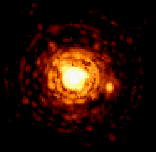Ross 128
 |
Ross 128 is a dim, main-sequence red dwarf that is comparable to the brighter of the two stars, Gliese 623a, shown in the NASA HST image at left. |
"This dim star lies about 10.9 light-years (ly) away in the northeastern corner (11:47:44.40+00:48:16.43, ICRS 2000.0) of Constellation Virgo, the Maiden -- south of Zavijava (Beta Virginis). It is too faint to be seen with the naked eye. The star was discovered in 1925 by Frank Elmore Ross (1874-1960), who also took the first good infrared and ultraviolet photographs of Venus in 1923. Ross first reported on this star in his "Second List of New Proper-Motion Stars," Astronomical Journal (36:856)."(Solstation)
"This cool and dim, main sequence red dwarf (M4.1 Vn) has almost a third of Sol's mass, a tenth of its diameter, but only 33/100,000th of its luminosity. (Another reference suggests a tenth of Sol's mass, a fifth of its diameter, and 23/100,000 of its luminosity). Ross 128 would be only one of many unremarkable stars except that it appears to be a flare star as well as one of Sol's closest neighbors. In contrast to Proxima Centauri which is a "magnetically younger" flare star that is "activity saturated", however, Ross 128 is considered to be a more "evolved" flare star where its flare rate may have decreased somewhat with increased magnetic evolution (Andrew Skumanich, 1986)."(Solstation)
Sources:
- http://www.solstation.com/stars/ross128.htm
- Skumanich http://adsbit.harvard.edu/cgi-bin/nph-iarticle_query?1986ApJ...309..858S
Nearby Stars
Star Concepts
| HyperPhysics***** Astrophysics | R Nave |